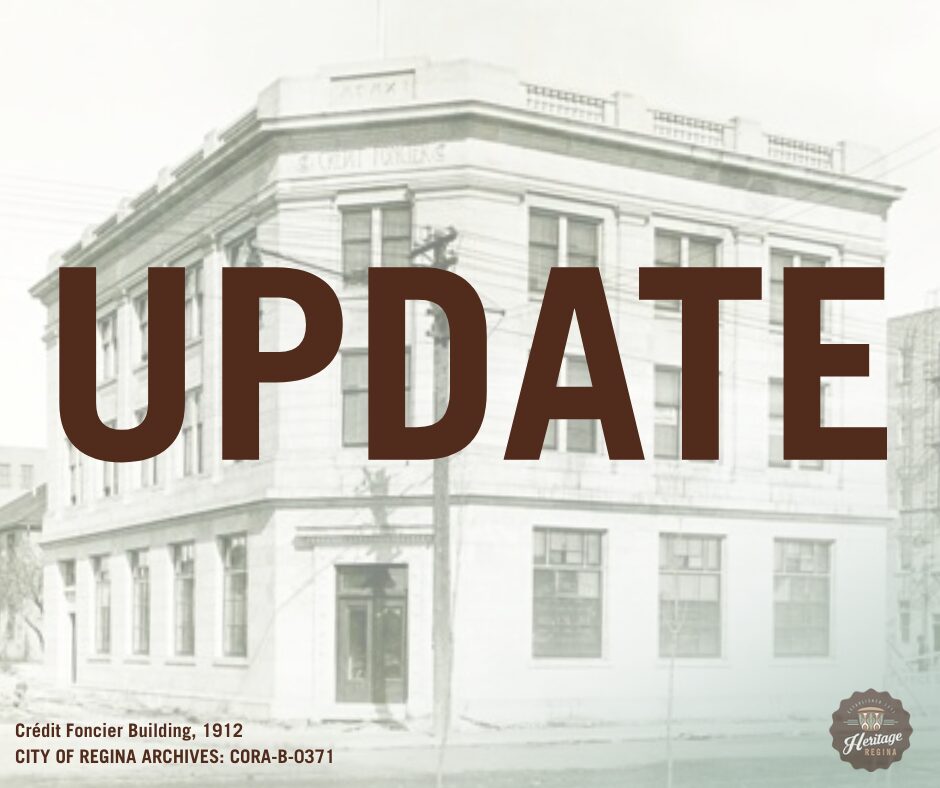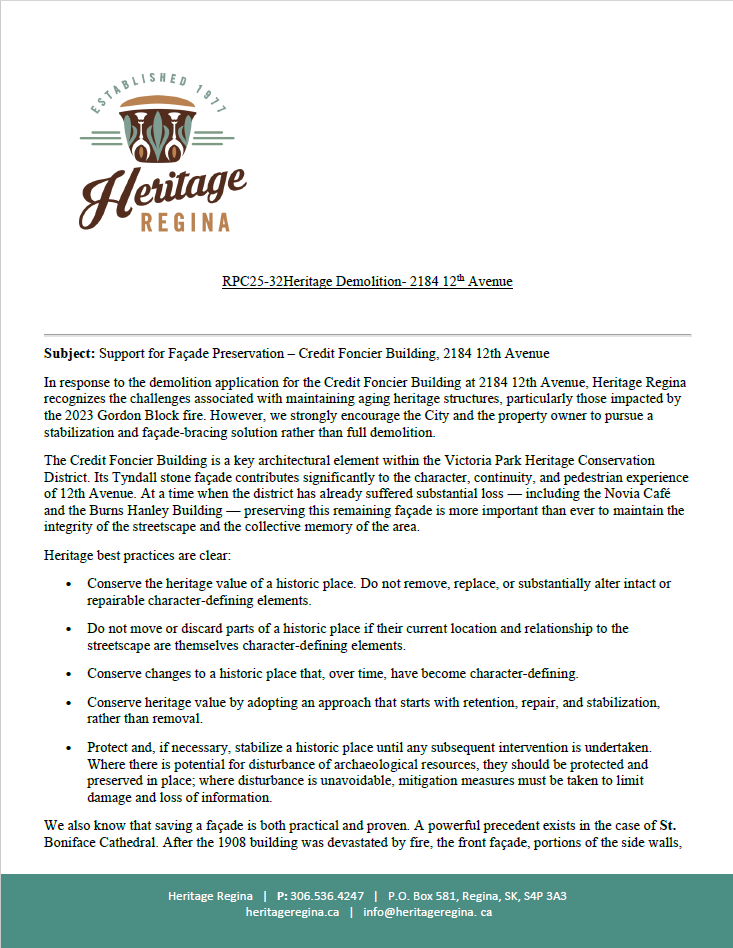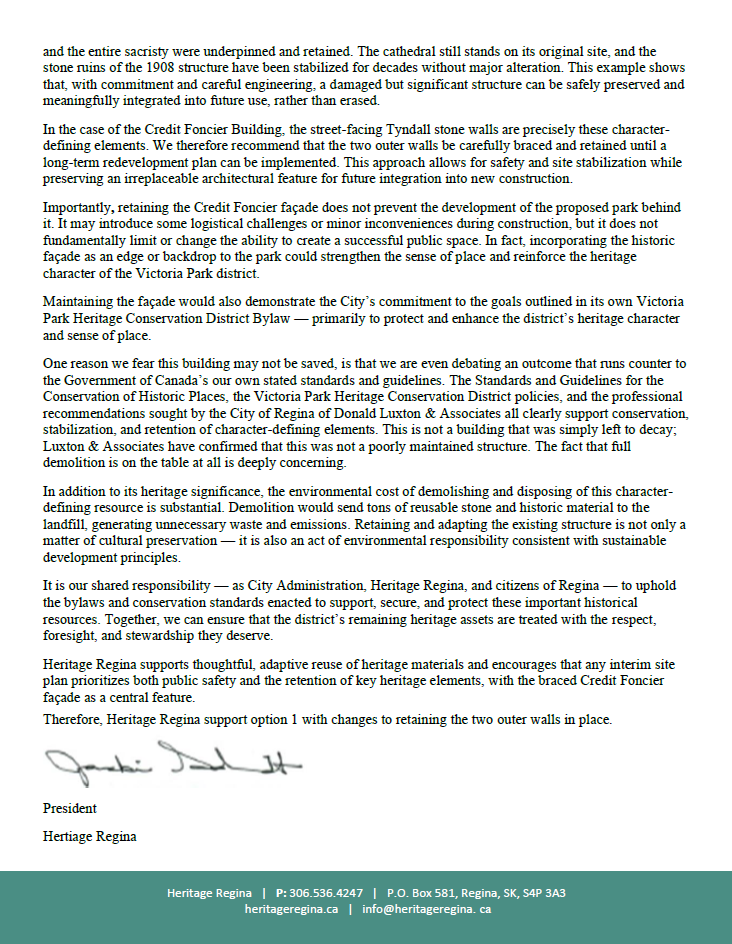Heritage Regina’s response to City Council’s decision regarding Crédit Foncier.


The City of Regina City Council will be discussing the future of the Crédit Foncier building on corner of 12th Avenue and Cornwall St at their meeting today, December 3rd 2025.
Heritage Regina will be presenting to city council our request to preserve the heritage of the site.

Crédit Foncier Building, 1912
” Our request is clear and reasonable:
Retain and underpin the two Tyndall stone façades, allowing the remainder of the building to be removed or redeveloped as needed to accommodate the City’s proposed Skuare Park and the property owner’s long-term
plans”
You can read our full letter to City Council here:
Credit Foncier Dec 3rd finalOur speaker for Thursday’s lecture The Torch Be Ours: Honouring Military Service, Ed Staniowski, appeared on CTV Your Morning Saskatchewan today.
Ed discusses his connection to Regina and gives us a little preview of what to expect this Thursday, November 27 at the Artesian (2627 13th Ave).
The lecture starts at 7:00 PM and admission is free. A suggested donation of $10 per person helps Heritage Regina continue to present educational content like this lecture.
Check out the interview here:
CTV Your Morning Saskatchewan: The Torch Be Ours: Honouring Military Service
A temporary relief for heritage properties downtown!
After our presentation, the City Planning Commission voted 8 to 1 to oppose the demolition of the Crédit Foncier.
The decision will be put forward to City Council on November 17 for a final decision.
Continue to give us feedback in the comments of our social media posts so we can make your voice heard as we advocate to save a downtown cornerstone.


 More on Tenille:
More on Tenille:Did you know that 2025 will only be the fourth time the Roughriders have hosted the CFL Western Final as we know it?

Kickoff of the CFL West Final Game 3 at Taylor Field. (Photo sourced from a YouTube video of the game highlights published by Paul Woods)

Ron Lancaster hands the ball off George Reed. Photo Sourced from the Canadian Press via CBC.ca

QB Darian Durant and LB Kitwana Jones wave to Durant’s parents in the stands after defeating the Stampeders 27-14 (Photo sourced from TSN Broadcast)

QB Cody Fajardo moments after doinking a pass of the field goal crossbar in a last second attempt to beat the Blue Bombers in the CFL 2019 West Final. (Screenshot Sourced from TSN Broadcast)
The Heritage Conservation Branch of the Saskatchewan Government is looking for feedback regarding the Heritage Property Designation Program.
Deadline for providing feedback is October 8, 2025.
Replies to the questions listed below can be directed via email to:
Krista Liggett
krista.liggett@gov.sk.ca
General questions regarding the current Heritage Property Designation Program
General questions about commemorating heritage in Saskatchewan
If not, what would be a better way to recognize SK Heritage?
Thanks in advance for considering our request for information and we look forward to hearing from you. If you have any questions or would like to have a conversation, please reach out to me directly.
Our 2025 Summer Walking Tour series has come to an end. We want to thank each and every person who attended a tour this year. Your support helps Heritage Regina continue to present engaging events and share our city’s rich heritage.
Please take a few minutes to fill out our 2025 Summer Walking Tour Survey. We want your opinion even if you did not attend any of the walking tours in 2025.
"*" indicates required fields
Thank you for completing our survey! Your feedback is much appreciated. Watch out for the launch of our 2026 Lecture Series and don’t miss Regina’s most Historic Haunt, Ghosts of the College Avenue Campus, returning this October.
Under the direction of Heritage Regina’s Board of Directors, the Program Coordinator will lead the development and execution of Heritage Regina’s events and programming.
Responsibilities:
What You Bring:
Assets
Pay rate: $25/hour. Though hours may vary depending on the time of year, the Coordinator will work a minimum of 40 hours per month.
To apply, submit a resume and cover letter to info@heritageregina.ca by 11:59 PM (CST) on Monday September 8th, 2025. While we thank all those who apply, only those selected for an interview will be contacted.
Heritage Regina is a an equal-opportunity employer and strives to be an ally to minority groups in its work and hiring. We welcome applications from folks within Indigenous, Métis, disabled, 2SLGBTQ+, and other minority communities.
Our friends at the Wascana Centre have produced a final draft of their 2025 Master Plan. They have opened a window for public feedback on the plan before they move to the next stage in developing the document.
From July 13th – July 27th you can read through their final draft of the 2025 Master Plan and provide feed back via their website.
To learn more about the Wascana Centre 2025 Master Plan and provide your feedback you can follow the link below to the Wascana Centre website.